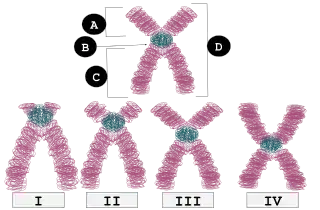Robertsonian translocation
Robertsonian translocation (ROB) is a chromosomal abnormality wherein a certain type of a chromosome becomes attached to another. It is the most common form of chromosomal translocation in humans, affecting 1 out of every 1,000 babies born. It does not usually cause health difficulties, but can in some cases result in genetic disorders such as Down syndrome and Patau syndrome.[1] Robertsonian translocations result in a reduction in the number of chromosomes.
Mechanism

II in the image), where the short arms are fairly short but not very short.A: Short arm (p arm)
B: Centromere
C: Long arm (q arm)
D: Sister chromatids
In humans, Robertsonian translocations occur in the five acrocentric chromosome pairs (chromosome pairs where the short arms are fairly short), namely 13, 14, 15, 21 and 22. The participating chromosomes break at their centromeres and the long arms fuse to form a single, large chromosome with a single centromere.
A Robertsonian translocation is a type of translocation involving two homologous (paired) or non-homologous chromosomes (i.e. two different chromosomes, not belonging to a homologous pair). A feature of chromosomes that are commonly found to undergo such translocations is that they possess an acrocentric centromere, partitioning the chromosome into a large arm containing the vast majority of its genes, and a short arm with a much smaller proportion of genetic content. The short arms also join to form a smaller reciprocal product, which typically contains only nonessential genes also present elsewhere in the genome, and is usually lost within a few cell divisions. This type of translocation is cytologically visible, and can reduce chromosome number (from 23 to 22 pairs, in humans) if the smaller chromosome that results from a translocation is lost in the process of future cellular divisions. However, the smaller chromosome lost may carry so few genes (which are, in any case, also present elsewhere in the genome) that it can be lost without an ill effect to the individual.[2][3]
Consequences
In humans, when a Robertsonian translocation joins the long arm of chromosome 21 with the long arm of chromosomes 14 or 15, the heterozygous carrier is phenotypically normal because there are two copies of all major chromosome arms and hence two copies of all essential genes.[4] However, the progeny of this carrier may inherit an unbalanced trisomy 21, causing Down syndrome.
About one in a thousand newborns have a Robertsonian translocation.[5] The most frequent forms of Robertsonian translocations are between chromosomes 13 and 14, 14 and 21, and 14 and 15.[1]
A Robertsonian translocation in balanced form results in no excess or deficit of genetic material and causes no health difficulties. In unbalanced forms, Robertsonian translocations cause chromosomal deletions or addition and result in syndromes of multiple malformations, including trisomy 13 (Patau syndrome) and trisomy 21 (Down syndrome).
A Robertsonian translocation results when the long arms of two acrocentric chromosomes fuse at the centromere and the two short arms are lost. If, for example, the long arms of chromosomes 13 and 14 fuse, no significant genetic material is lost—and the person is completely normal in spite of the translocation. Common Robertsonian translocations are confined to the acrocentric chromosomes 13, 14, 15, 21 and 22, because the short arms of these chromosomes encode for rRNA which is present in multiple copies.
Most people with Robertsonian translocations have only 45 chromosomes in each of their cells, yet all essential genetic material is present, and they appear normal. Their children, however, may either be normal, carry the fusion chromosome (depending which chromosome is represented in the gamete), or they may inherit a missing or extra long arm of an acrocentric chromosome (phenotype affected). Genetic counseling and genetic testing is offered to families that may be carriers of chromosomal translocations.
Rarely, the same translocation may be present homozygously if heterozygous parents with the same Robertsonian translocation have children. The result may be viable offspring with 44 chromosomes.[6]
Name
Robertsonian translocations are named after the American zoologist and cytogeneticist William Rees Brebner Robertson (1881–1941) who first described a Robertsonian translocation in grasshoppers in 1916.[2] They are also called whole-arm translocations or centric-fusion translocations.
References
- Unique: Rare Chromosome Disorder Support Group
- Robertson WRB. Chromosome studies. I. Taxonomic relationships shown in the chromosomes of Tettigidae and Acrididae. V-shaped chromosomes and their significance in Acrididae, Locustidae and Gryllidae: chromosome and variation. J Morph 1916;27:179-331.
- Hartwell, Leland; Hood, Leroy; Goldberg, Michael; Reynolds, Ann; Silver, Lee (2011). Genetics From Genes to Genomes, 4e. New York: McGraw-Hill. pp. 443, 454. ISBN 9780073525266.
- Peter J. Russel; Essential Genetics 2003
- E. Therman, B. Susman and C. Denniston. The nonrandom participation of human acrocentric chromosomes in Robertsonian translocations. Annals of Human Genetics 1989;53:49-65.
- Martinez-Castro P, Ramos MC, Rey JA, Benitez J, Sanchez Cascos A (1984). "Homozygosity for a Robertsonian translocation (13q14q) in three offspring of heterozygous parents". Cytogenet Cell Genet. 38: 310–2. doi:10.1159/000132080. PMID 6510025.